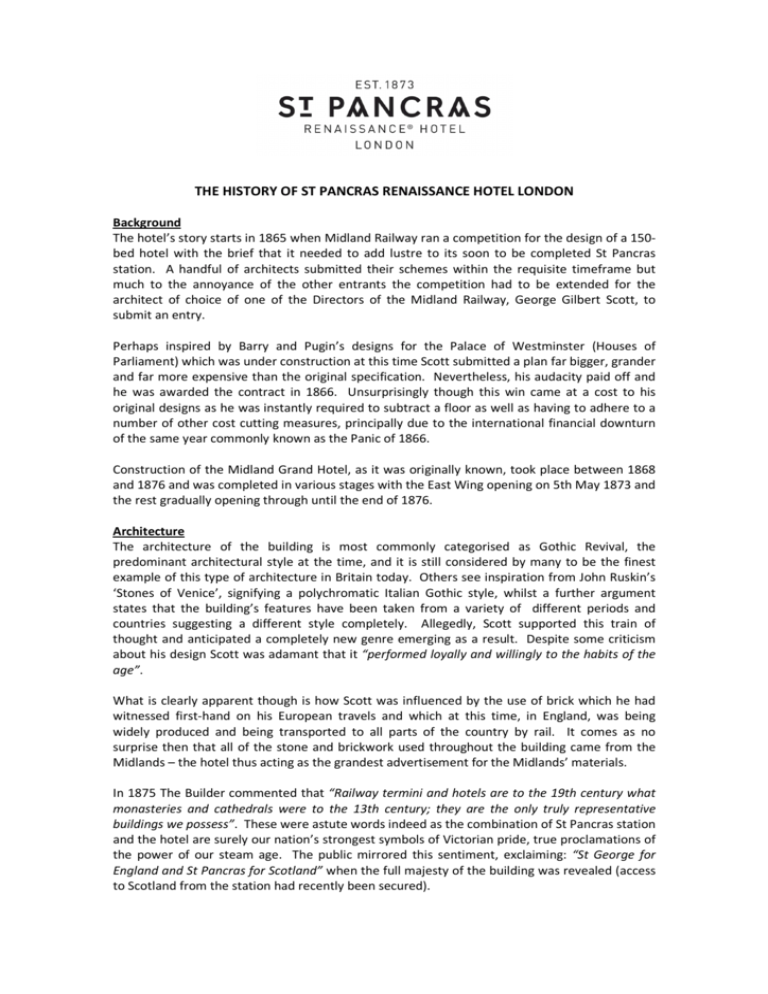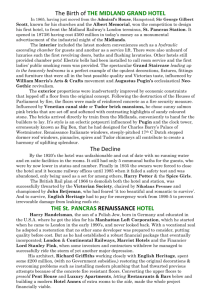the history of st pancras renaissance hotel london
advertisement

THE HISTORY OF ST PANCRAS RENAISSANCE HOTEL LONDON Background The hotel’s story starts in 1865 when Midland Railway ran a competition for the design of a 150bed hotel with the brief that it needed to add lustre to its soon to be completed St Pancras station. A handful of architects submitted their schemes within the requisite timeframe but much to the annoyance of the other entrants the competition had to be extended for the architect of choice of one of the Directors of the Midland Railway, George Gilbert Scott, to submit an entry. Perhaps inspired by Barry and Pugin’s designs for the Palace of Westminster (Houses of Parliament) which was under construction at this time Scott submitted a plan far bigger, grander and far more expensive than the original specification. Nevertheless, his audacity paid off and he was awarded the contract in 1866. Unsurprisingly though this win came at a cost to his original designs as he was instantly required to subtract a floor as well as having to adhere to a number of other cost cutting measures, principally due to the international financial downturn of the same year commonly known as the Panic of 1866. Construction of the Midland Grand Hotel, as it was originally known, took place between 1868 and 1876 and was completed in various stages with the East Wing opening on 5th May 1873 and the rest gradually opening through until the end of 1876. Architecture The architecture of the building is most commonly categorised as Gothic Revival, the predominant architectural style at the time, and it is still considered by many to be the finest example of this type of architecture in Britain today. Others see inspiration from John Ruskin’s ‘Stones of Venice’, signifying a polychromatic Italian Gothic style, whilst a further argument states that the building’s features have been taken from a variety of different periods and countries suggesting a different style completely. Allegedly, Scott supported this train of thought and anticipated a completely new genre emerging as a result. Despite some criticism about his design Scott was adamant that it “performed loyally and willingly to the habits of the age”. What is clearly apparent though is how Scott was influenced by the use of brick which he had witnessed first-hand on his European travels and which at this time, in England, was being widely produced and being transported to all parts of the country by rail. It comes as no surprise then that all of the stone and brickwork used throughout the building came from the Midlands – the hotel thus acting as the grandest advertisement for the Midlands’ materials. In 1875 The Builder commented that “Railway termini and hotels are to the 19th century what monasteries and cathedrals were to the 13th century; they are the only truly representative buildings we possess”. These were astute words indeed as the combination of St Pancras station and the hotel are surely our nation’s strongest symbols of Victorian pride, true proclamations of the power of our steam age. The public mirrored this sentiment, exclaiming: “St George for England and St Pancras for Scotland” when the full majesty of the building was revealed (access to Scotland from the station had recently been secured). Interior and Exterior The status schematics of the hotel were contrary to the hotels of today; the Midland’s grandest rooms were on the lower three floors with the upper floors providing more basic rooms and staff accommodation. This was exemplified by the finish and size of the rooms: the first floor rooms were 18ft high with Axminster carpets and walnut furniture with gold inlay; by the third floor the carpets were Saxony and the ceilings had a height of only 13ft. For a building of this size and style which required the use of gas lighting, every trick was used in its construction to allow as much natural light in as possible: huge rooms with huge windows; ornate, gothic fanlights above every door; as well as wonderfully arched stairwells. The most famous of these and widely considered the most majestic in the country is the Grand Staircase. This extraordinary double staircase is a fantastic example of high-Victorian, gothic decoration. The ballustrading, in wrought iron, contains original gas fittings and snakes three stories up to a vaulted ceiling, the most obvious suggestion of Scott’s reputation as the most eminent ecclesiastical architect of the age. During his lifetime he either designed or collaborated on over eight hundred churches and worked on all but two of Britain’s cathedrals. This vaulted ceiling is painted with stars as well as the Virtues and heraldic arms of the Midland Railway. Unusually and quite possibly uniquely, in the stone stairwell below there are still the exotic remains of the Ishlac, the Islamic wooden “veil” behind which Turkish coffee was sipped. Both the width of this staircase as well as the corridors is also markedly wide by today’s standards the reason being that it allowed two ladies in bustles to pass. The fixtures and fittings throughout the hotel were finished to the highest standards primarily supplied by Gillows (latterly Waring & Gillow). The hotel oozed extravagance; the Victorian decor was luxurious and lavish with extensive decoration in gold leaf and open fires in every room. Ornate stencilling and flamboyant wallpapers governed every inch of the hotel, much of which is being unveiled and restored for the first time in decades. In the Dining and Coffee Room (now The Gilbert Scott restaurant) pillars of polished limestone lined the walls with their gilded capitals carved with conkers, pea pods and peas and bursting pomegranates. The Ladies’ Smoking Room (actually the gentlemen’s and ladies’ smoking room but because it was the first room in Europe in which ladies could smoke publicly it became known as this) housed one of the most elaborately decorated ceilings in the hotel as well as granite pillars, carved stonework and two great fireplaces of different coloured marbles. Each of these features is being beautifully restored. Scott used a wide range of gothic features in the hotel both externally and internally with nine stone masons employed to work on the building’s capitals, head stops and gargoyles as well as other details. Altogether, the total costs of the building added up to £438,000 (approx. £438m today). Although the results were spectacular this was an extortionate amount and even Scott commented that “it is almost too good for its purpose”. Despite this, it represented one of the most audacious statements of the economic power of the railway companies at this time. Innovations Over and above all of these features the hotel also set new benchmarks in the hospitality industry. There were two “hydraulic ascending chambers” (lifts), which transported guests up and down the four principal stories and the hotel also featured a unique calling system of electric bells (similar to the traditional bell calling system which was currently in use in private houses at this time). In addition to this, the building housed concrete floors, 22 inch thick, with an innovative fireproof floor construction and contrary to popular belief the hotel did in fact have flushing toilets which was almost unheard of for a hotel at this time. Innovations, however, didn’t stop upon opening, they continued throughout the hotel’s lifetime: in 1899 a specially designed revolving door was fitted in the hall entrance which was supplied by the inventor of the revolving door, Theophilus Van Kannel and in the same year electric lifts were installed replacing one of the original water-driven ones. Heyday The Midland Grand’s reputation was quickly cemented and it was widely recognised as one of London’s leading hotels. Apart from The Langham on Portland Place it was the most expensive hotel in London. Rooms were charged between 3s6d and several pounds a night. The hotel was commissioned to fulfil various functions; the primary, obviously, was as a hotel and the huge cash injections that the Midland Railway received as a result of guests arriving into London and checking straight into the Midland Grand made a significant contribution to the company’s annual profits. Another very important function was endorsing the Midland Railway’s reputation, which it did with undoubted success dwarfing all competition in its size and splendour which at a time when there were over two hundred different rail companies proved a massive advantage. Guests of note during the hotel’s heyday included Johnnie Walker (of Scotch fame), Jesse Boot (of Boot’s the chemist), the actress Marie Lloyd, Commodore Vanderbilt, one of American’s richest men and the American inventor and industrialist, George Pullman. Decline The hotel continued to make a profit until post WWI but it then became too expensive to both maintain and heat. Another contributing factor was the severe deficiency in bathrooms; only five bathrooms housing a total of nine baths were available to serve the three hundred bedrooms with an army of servants having to fill in for the rest. When the hotel was first built the fact that there were bathrooms at all was a novelty but with a number of significant hotel openings in the early 20th century en-suite bathrooms became more and more commonplace. Unfortunately, what was considered innovative at its construction turned out to be its primary downfall: due to the thickness of the hotel’s floors it was impossible to introduce the necessary plumbing in order to bring the hotel up to the standards of its competitors. Despite novelties such as a Moroccan coffee house and an in-house orchestra the hotel couldn’t be saved from these problems. In 1922 the Midland Railway was forced into grouping with other railway companies and so the hotel became the property of London, Midland and Scottish Railway (LMSR) before its eventual closure in 1935. Its facilities couldn’t vie with its competitors and the expense in running it had become too great. Following the hotel’s closure to the public it then came to accommodate British Rail staff. It was during this time that the building’s structure was tested to its limits. During WWII it was bombed three times in one month but as credit to the strength of its construction fortunately it emerged almost completely unscathed. In 1948 it became the HQ for British Transport Hotels and remained so until Thatcher’s government privatized the non-core businesses of British Rail, which included the BTH. British Rail continued to use it itself until a failed fire certificate forced them out in 1985. During its time as British Rail offices a lot of the original stenciling and paintwork was painted over and tiles and stone columns boarded up, something that seems almost criminal now that it is all being uncovered. It was also during this period that huge attempts were made to demolish it: its close proximity to Kings Cross and Euston Stations made it almost redundant and there was also a strong movement against this type of overtly Gothic architecture at the time. Fortunately and despite his worry that it was “too beautiful and too romantic to survive”, a quest led by Sir John Betjeman resulted in it being granted Grade I listed status in 1967 which ensured its preservation for the future. Between 1990 and 1995 the planning and implementation of a “package of safety” works was undertaken which included restoring the external building to its original condition and making it structurally sound and weatherproof. Following this it then became a popular choice for film and TV locations (Gulliver’s Travels, Batman Begins, Shirley Valentine, The Secret Garden, Bridget Jones’ Diary, From Hell, The Golden Bowl, Nicholas Nickleby and The Lost Prince amongst many others), photoshoots (including Brides and GQ) and video shoots (most famously as the backdrop to the Spice Girls’ video for their inaugural hit ‘Wannabe’). Revival In 1996, following the announcement of the new, international station at St Pancras, London & Continental Railways (the building’s leaseholder) put out a competition in order to select a development team to restore and re-open the building. A consortium of BAA Lynton (British Airport Authority’s commercial property division), Manhattan Loft Corporation (MLC) and Whitbread (franchisee of Marriott Hotels in the UK) won the restoration and refurbishment project in 2002, the winning proposal combining a high quality hotel with loft apartments above. Originally MLC was only responsible for the development of the apartments but following BAA’s sale of its commercial property arm and Whitbread losing its franchisee of Marriott Hotels in the UK, Harry Handelsman, CEO of MLC, made the bold decision to undertake the development of the whole building. Marriott International in the US was approached to manage and operate the hotel and it was soon decided that it would become one of Renaissance’s flagship hotels as it embodied so many of the brand’s core values. Future The St Pancras Renaissance Hotel London will formally open on 5th May 2011, exactly 138 years after the Midland Grand Hotel originally opened. It will be the final piece of the St Pancras regeneration project, which has included a £800 million restoration of the Station. The station was re-opened as St Pancras International, by Her Majesty the Queen in November 2007. As the hotel enters a new era the many admirers of arguably Scott’s finest work watch on with both fascination and excitement as this extraordinary building is given the kiss of life. The sixty-six apartments situated on the upper floors of the building were completed last year and are now all occupied. The conversion was received with huge reverence by critics, journalists and owners alike and now the focus is on the hotel. The St Pancras Renaissance Hotel London will accommodate the majority of areas of historical importance resulting in a 5* wonder exuding contemporary grandeur. Timeline St Pancras Who was St Pancras? Pancras was a Roman orphan who was brought up by his uncle, Dionesis, in Rome. He was executed on 12th May 304 AD, aged 14, during Diocletian’s persecution of Christians for refusing to betray his Christian faith. It is believed that ten years later the first church of this parish was built on the site of a Roman encampment overlooking the River Fleet and is considered to be one of the oldest sites of Christian worship in England. The Fleet flowed under Battle Bridge (the original name for King’s Cross). A successor to this shrine was rebuilt in medieval times and again in 1848 and still stands in the old churchyard on Pancras Road, behind the station. Much of the churchyard had to be cleared in the 1860s to enable the new station and hotel to be built.






